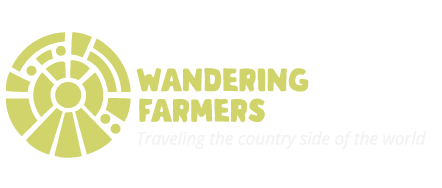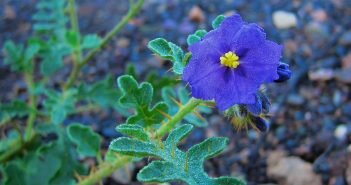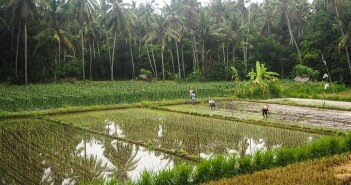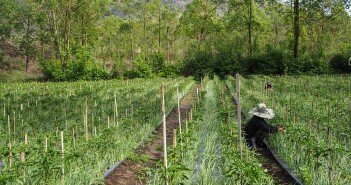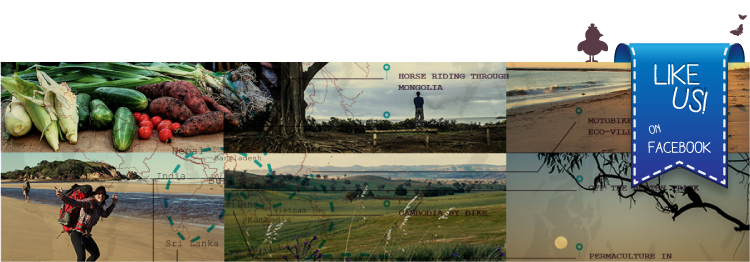Caroola Farm is a family owned, Permaculture demonstration and profitable sustainable farm, providing a healthy and diverse food basket for the local community. Penny Kothe and Paul McKinnon started the farm in 2012 and produce nutritious and organic herbs, vegetables, fruits, chickens, ducks, turkeys, beef, lamb, pork and eggs, with more fruits varieties and nuts on the way.
Penny has been kind enough to share with me the Caroola permaculture plan designed by Earth Integral and talked me through how they implemented it and things they decided to change. If you are interested in Permaculture design and sustainable farming read on.
Caroola Site Analysis
The objectives are:
- Create a highly productive and diverse landscape
- Improve and regenerate the land (biodiversity, water retention…)
- Create a productive farm providing a diverse basket of food for the local community
- Inspire and educate people about sustainable farming and Permaculture
- Becoming a hub for the community interested in Permaculture and sustainable farming
Site Location:
- Address: 9074 Kings Highway Mulloon NSW 2622 – 50km drive East of Canberra
- Elevation: 710-730m
- Landscape: Gently undulating slopes (20% on average), cleared pasture and some open Eucalyptus woodland)
Site History:
Previously Caroola farm was a pony stud. Set stocked grazing management was the norm (leave the horses on the same paddock all year round), which led to erosion, run off and compacted soil. A bushfire also ravaged the property 1 year after Penny and Paul took over in 2013.
Climate:
- Cold winters as low as -12 on average with a risk of frost almost 11 months per year
- Hot and dry summers with an average of 30 days per year above 30 degrees
- Spring winds coming from North West can be relentless and freezing
- Rain is quite regular all year round with annual rainfall of 720mm. The wetter months are June July and the drier months are January and February.
Water Resources:
- Mulloon Creek: pumping right for stock and domestic purposes
- Bore: deep and sandy so the water is drinkable
- 9 storage dams
Soil:
The topsoil is brownish black loamy and sandy, and then there is a greyish sandy soil and a bright yellowish sandy soil. Further below the soil is clay.
The soils has a high permeability so during rainfall, water infiltrates the soil easily until it hits the clay subsoil and then it stops. It results in a perched water table following high rainfall and a high waterlogging potential at time.
During summer the sandy topsoil dry quickly and the strong wind plus the low organic matter can lead to erosion.
Opportunities and Constraint of Caroola Site
Opportunity:
- Frost: Niche for frost loving plants such as Hazelnuts
- Kings Highway: great location for potential customers for an on farm shop and education centre
- 20% slope, anything is possible
- 9 dams and a drinkable bore
- Massive dam near building: Opportunity for a natural swimming pool and a recreational area
- Clay soil: good water holding potential, a number of dams stayed full during the last drought
Constraints:
- North West winds both hot and dry in summer and cold in spring
- Solution: Shelterbelts and windbreaks
- Soil structure, low fertility and potential erosion,
- Solution: Improve the soil structure using yeoman’s plowing, animal systems, and a grazing plan
- Waterlogging potential
- Solution: Tree mounts
- Frost
- Solution: Planting frost loving plants, mulch, polytunnel and an isolated cloche tunnel system over the vegetable crops
- Fire risk coming from North West:
- Solution: Prioritise fire resistant species in the Northern shelterbelt and graze western paddock before fire season.
- Low micro and macro nutrients
- Solution: mineral amendments (biological management)
- Foxes for poultry:
- Solution: Maremma dogs and foxes light
Caroola Farm Permaculture Master plan:
Education and public shop front:
Build a multi-purpose passive solar system classroom, shop front and amenities.
Berry system:
The busiest time of the year on the Kings Highway is Christmas so a berry system would provide a good source of revenue from passers by on holiday. The berry system would include various berries, ducks, trouts and a terraquaculture system. Terraculture is the practice of farming living water flowing through the landscape. It is the traditional farming system of the Asia-Pacific region.
The system will have swales and a pump to circulate the water from the dam back in the terraquaculture system.
Oak-Hazel Dehesa:
Dehesa is an agroforestry system, which integrate livestock, crops, herbaceous vegetation and a mix species of oak forest. The nuts from the oak and hazelnuts will provide food for pigs in the late summer to autumn. The herbaceous vegetation provides food for the sheep, cattle and poultry during winter and early spring. In addition of meat and eggs, the system will provide hazelnuts and firewood. The hazelnuts were chosen because it is the perfect tree for Caroola Farm from an economic and environmental point of view. Harvest period is right before Easter holiday (a busy period on the Kings Highway). Over 2000 tones are imported annually in Australia. They tolerate -10c during period of pollination and are usually unaffected by late spring frost.
Time controlled grazing:
It is basically managing cattle by mimicking the wild herd movement also called holistic grazing management. The plan at the moment at Caroola is 10 cows, 1 bull and an average of 6 calves for 7 paddocks of 5 hectares divided into 5, which makes 35 paddocks of 1 hectare. Grazing management is different from set stocking where the cows are left in the same paddock all the time. It is also different from rotational grazing which usually follows a set rotating plan of a certain number of days for each paddock. Holistic grazing management is about managing the pasture because the grass grows at a different rate depending on the season. For example in spring the grass might take 3 to 4 days to start to regrow and in winter it might take 2 weeks. “So you will have to move the cows more often in spring so the pasture does not get overgrazed no matter how big is your paddock.” Says Penny. In spring summer the management is more about making sure the pasture is not overgrazed and in winter it is more about ensuring that you will have enough feed. As an example, the pasture might get a 30 days rest in winter as you have to move the cows often and the grass grows quickly. Though in winter the pasture might get 180 days of rest. Penny says “overgrazing is a matter of time not space or quantity of cattle.” In one hectare you could easily have up to 30 cows and 20 calves though you might not have enough grass in wintertime. Penny and Paul will also mix cows and sheep as the sheep eat different grass and the cows will protect them from foxes. Then they will rotate chickens so they can eat the bugs and insects and spread the manure before the paddock gets a short rest and the cows are moved back in.
Forage woodland tree belt:
Each paddock has a forage tree belt (mainly honey locust) planted on contour on the ridge facing west to provide autumn forage, dappled shade and shelter to the cattle. The belt is strategically place at the top of the hill so the nutrient will flow down. The water for the cattle is placed at the bottom to encourage the cows to travel up and down and distribute nutrients even more.
Casuarina windbreak:
These trees are planted on contour west of the forage woodland tree belt to protect livestock. There was a straight windbreak of pine trees but they died during the fire. The Casuarina has many benefits including fixing nitrogen, great for wood products and easy to propagate. The Casuarina also tolerates drought, frost, fire, waterlogging and a wide range of soils.
Native Grassy woodland:
An area of the farm left for wildlife and for natural regeneration.
Mix Forestry Northern Shelterbelt:
This belt is planted on contour and provides a very important windbreak from the North West wind as well as providing a screen from neighbors and wood for various purposes. It will also be planted with fire resistant species to protect the farm from possible fire coming from the North West.
Mix Forestry Southern Shelterbelt:
This belt is also planted on contour and provides a screen for pollution noise and potential chemical spraying coming from the Kings Highway. The trees will also provide firewood, poles, posts and feed supplements. This belt is located on a ditch so the tree species will be adapted to a wetter environment.
Floodplain Silvopasture:
A silvopasture system is simply the practice of combining forestry and grazing of domesticated animals in a mutually beneficial way. The advantages are enhanced soil protection and increased long-term income due to the simultaneous production of trees and grazing animals. The Oak-Hazel Dehesa is also a Silvopasture system. Being a floodplain, this area as an alluvial soil, one of the best soils on the farm. The original plan was to plant trees, which demand nutritious, and highly drained soil to harvest premium quality wood. As this part of the farm hasn’t been planted yet, Penny and Paul are thinking of using it to extend the market garden.
